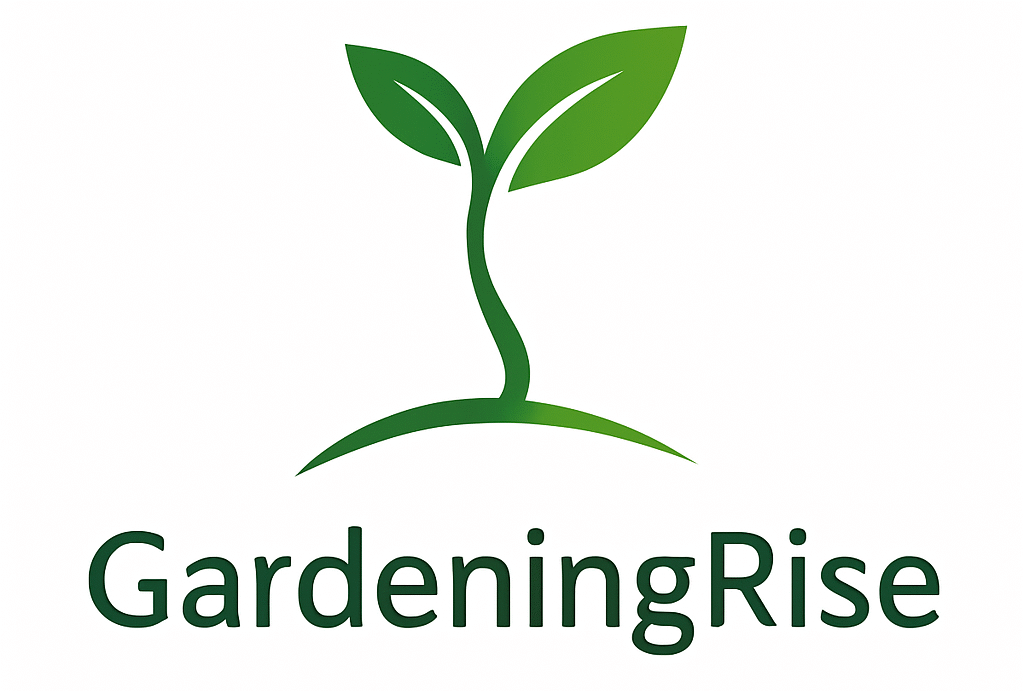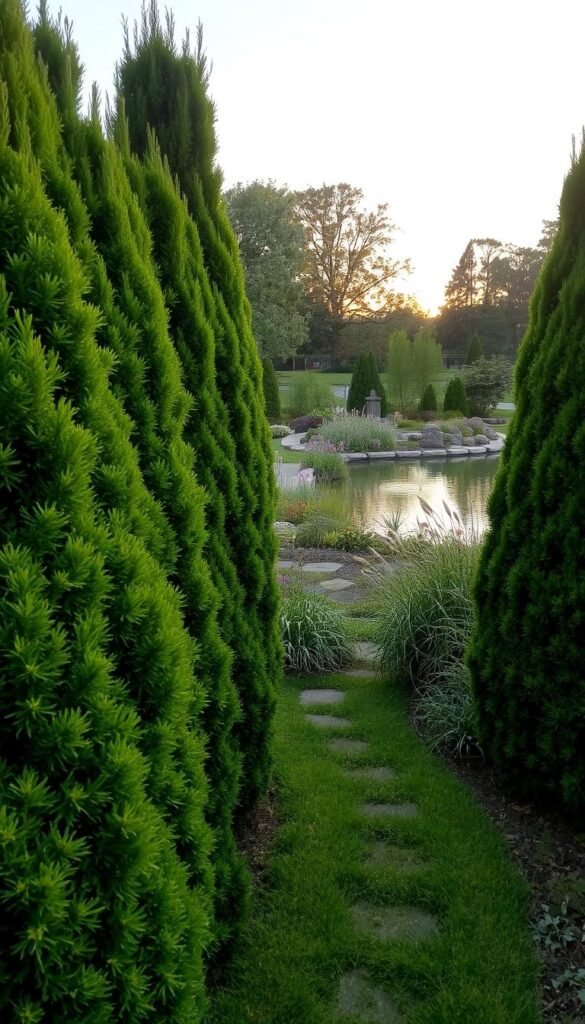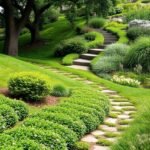Your outdoor space can become a personal retreat with the right approach. Thoughtful garden design blends beauty and practicality, turning your yard into a sanctuary where nature thrives alongside comfort. Whether you’re working with a cozy patio or sprawling backyard, every decision shapes how you experience the area.
A well-planned layout acts as the backbone of your project. It guides movement through the space while addressing privacy concerns naturally. Consider how structural features like trellises or raised beds interact with climbing vines and flowering shrubs to create visual barriers that soften over time.
Start by evaluating your property’s unique characteristics. Note where sunlight patterns shift during the day and identify sightlines from neighboring homes. These observations help position plants and hardscaping elements where they’ll deliver the most impact. Evergreen hedges might anchor key areas, while deciduous trees offer seasonal flexibility.
Balance immediate needs with future growth when selecting materials and plants. Fast-growing bamboo provides quick screening but requires containment, while slower-growing arborvitae offers lasting structure. Mix textures and heights to build depth, ensuring your design evolves gracefully without losing functionality.
Understanding Your Vision for a Private, Beautiful Garden
A garden that mirrors your personality begins with intentional planning. It’s not just about filling space—it’s about crafting an environment where you feel completely at ease. Start by asking yourself: What moments do I want to cherish here? Whether it’s quiet mornings with a book or lively evenings hosting friends, your goals shape every design choice.
Reflect on Your Garden Goals
Think about how you’ll use the area daily. Do you crave solitude or connection? A cozy nook for reading might need soft seating and shade, while dining areas benefit from open layouts. Your outdoor space should adapt to these needs without feeling cluttered. For example, tall grasses can frame seating zones while letting breezes flow through.
Incorporating Personal Style and Comfort
Your gardening aesthetic should echo your home’s interior. If modern minimalism defines your living room, clean-lined planters and geometric hedges might suit. Prefer cottage charm? Try overflowing flower beds with vintage accents. Comfort matters too—opt for weather-resistant cushions or built-in benches if you dislike moving furniture.
Balance beauty with practicality. Low-maintenance perennials save time, while evergreens keep screens lush year-round. Remember: your garden grows with you. Choose elements that age gracefully, like stone pathways or durable teak furniture, to build a timeless retreat.
Assessing Your Space and Privacy Needs
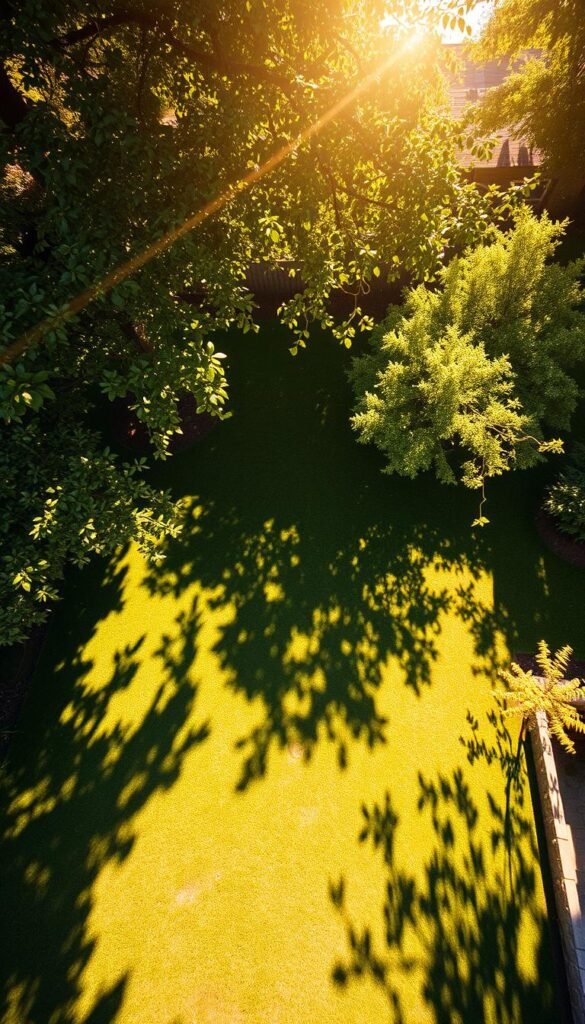
Effective privacy starts with a clear assessment of your outdoor environment. You’ll want to identify natural advantages and challenges in your yard before adding screens or plants. This groundwork ensures solutions fit seamlessly into your landscape while addressing specific concerns.
Sunlight, Breezes, and Existing Features
Track sunlight patterns by visiting your yard at dawn, noon, and dusk. Note where shadows fall during summer and winter—this helps position shade-loving plants or sunny seating areas. Full-sun spots might host tall grasses, while shaded corners could support ferns.
Wind direction matters more than you think. Stand in different zones during breezy days to feel where gusts hit hardest. Sheltered areas become ideal for delicate blooms, while wind tunnels need sturdy evergreens like juniper.
| Sun Exposure | Plant Suggestions | Privacy Level |
|---|---|---|
| Full Sun (6+ hours) | Arborvitae, Bamboo | High |
| Partial Shade | Hydrangeas, Boxwood | Medium |
| Full Shade | Hostas, Ferns | Low |
Existing trees or slopes can become privacy allies. A mature oak might anchor a seating nook, while a slope could hide compost bins. Measure distances between your patio and neighboring windows to calculate screen heights needed.
Balance openness with seclusion. Keep sightlines to favorite views—like a distant hilltop—while blocking second-story windows. Your backyard should feel like a retreat, not a fortress.
Planning Your Garden Layout with Purpose

Transform your yard into a functional oasis by starting with pencil and paper. A purposeful plan garden acts like a roadmap, helping you visualize how each element interacts before breaking ground. This step saves time and resources while ensuring every square foot serves your vision.
Sketching Your Design
Begin by outlining property boundaries and permanent fixtures like patios or mature trees. Trace natural pathways you already use—these often reveal the most intuitive flow for walkways. “Your feet know the best routes,” says landscape architect Mara Ramirez. “Work with them, not against them.”
Mark north-facing zones to identify sun patterns. Use tracing paper overlays to experiment with different layouts without erasing your base drawing. This lets you test options like curving paths around existing oaks or positioning seating areas near fragrant blooms.
Mapping Key Areas for Functionality
Divide your garden into activity zones that match daily routines. Keep herb beds near the kitchen door for quick access while cooking. Place fire pits or dining spaces where evening breezes won’t blow smoke toward seating.
Consider year-round usability. Leave space for winter storage bins near tool sheds and ensure snow-melt paths align with winter sun angles. Smart planning today means fewer headaches when seasons change.
Always leave room for growth—both plant maturity and evolving needs. A toddler’s play area might become a teen’s study nook, so choose flexible hardscaping that adapts over decades.
Creating Natural Privacy Screens with Strategic Plant Placement
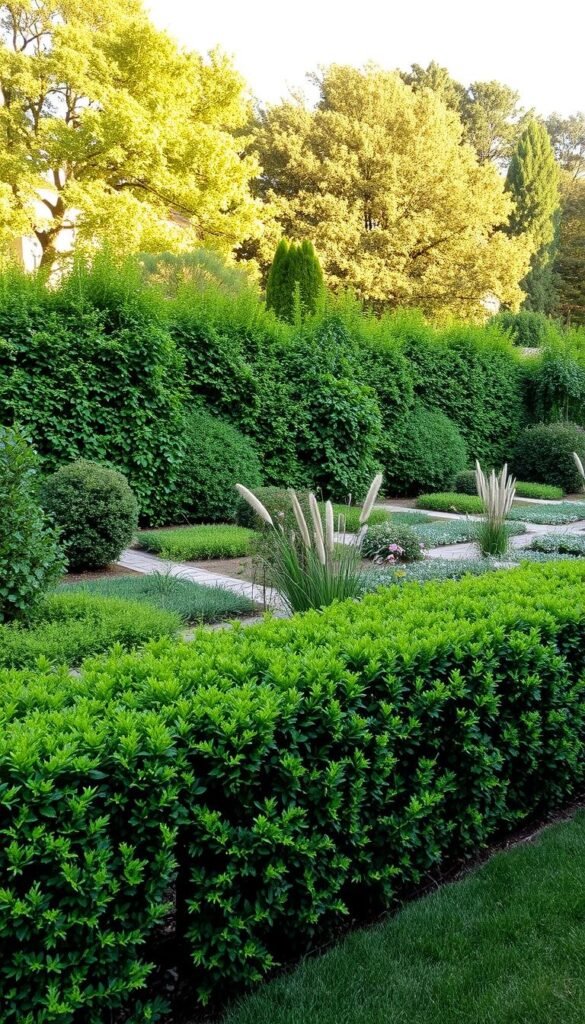
Nature’s own solutions can craft secluded spaces while enhancing your garden’s ecosystem. Living barriers do more than block views—they absorb noise, filter dust, and become habitats for birds and pollinators. By mixing plant types, you create layers that serve multiple purposes year-round.
Tall trees like maple or cypress form green ceilings over patios. They shield from upstairs windows while casting cooling shadows. Pair them with mid-height shrubs—boxwood for crisp edges or hydrangeas for loose texture. This combo blocks sightlines without feeling oppressive.
For narrow spaces, try vertical solutions. Climbing roses on trellises add color and movement. “Vines give instant height without swallowing ground space,” notes urban gardener Liam Chen. Combine them with ornamental grasses that sway gently, maintaining airflow. This works beautifully for container planting in tight areas.
- Evergreens: Year-round coverage (arborvitae, holly)
- Deciduous picks: Seasonal interest (redbud, witch hazel)
- Grasses: Soft screens (maiden grass, feather reed)
Always check mature sizes. A bamboo grove might need root barriers, while slow-growing yews stay manageable. Leave breathing room between plants—overcrowding leads to disease. With smart placement, your green walls become living art that grows better each year.
Choosing the Right Plants and Garden Beds

The magic of your sanctuary lies in smart plant partnerships. Thoughtful combinations transform ordinary beds into living tapestries that shift with the seasons. Start by considering how foliage, blooms, and textures interact to create dynamic scenes that hold interest even in winter.
Seasonal Selections and Colorful Choices
Mix evergreens like boxwood with flowering stars like coneflowers for year-round structure. Spring bulbs push through late-winter mulch, while summer hydrangeas take center stage. “Pair early bloomers with late-season performers to avoid gaps,” suggests horticulturist Elena Torres. This keeps beds lively from frost to frost.
| Season | Plant Type | Visual Impact |
|---|---|---|
| Spring | Tulips, Peonies | Bold colors |
| Summer | Daylilies, Lavender | Fragrant blooms |
| Fall | Sedum, Ornamental Kale | Textured foliage |
| Winter | Holly, Red Twig Dogwood | Structural interest |
Layering Plant Heights for Depth
Build drama by stacking heights like nature does. Place sky-reaching junipers behind mid-sized roses, then let creeping thyme spill over bed edges. This approach creates cozy nooks while making small spaces feel larger.
- Back layer: Tall grasses (Miscanthus)
- Middle tier: Shrub roses or dwarf lilacs
- Front row: Sedum or ajuga groundcover
Leave elbow room between plants—crowding invites pests. A well-planned bed matures gracefully, needing less pruning over time. Your choices today shape tomorrow’s private paradise.
Incorporating Structural Elements: Trellises, Pergolas, and Fences
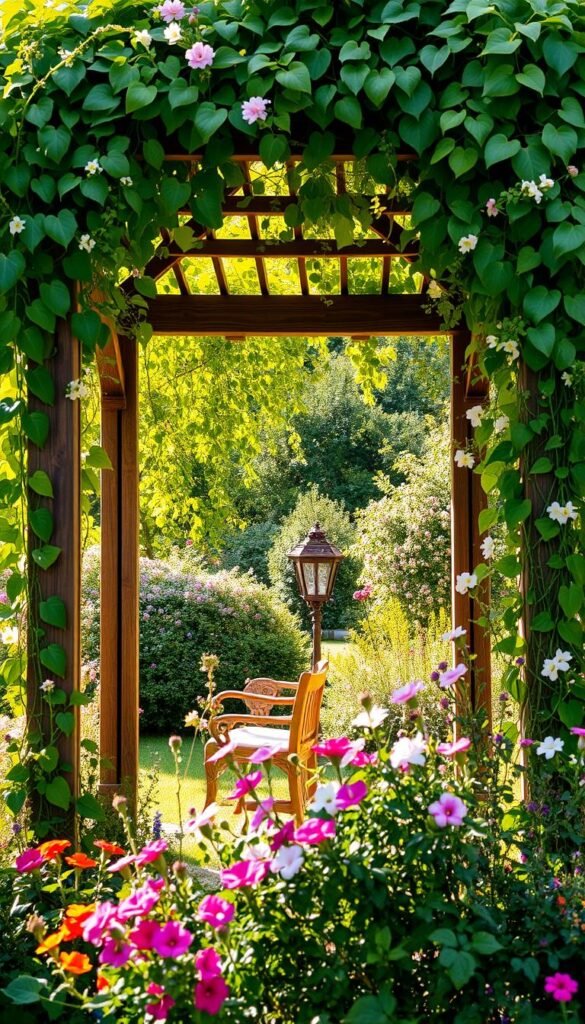
Vertical solutions transform how you experience limited areas. Trellises offer smart ways to expand upward while keeping your design intentional. These elements work overtime—supporting greenery today and shaping your space’s character tomorrow.
Enhancing Vertical Space with Trellises
Think of trellises as your garden’s upward architects. They let vining plants like cucumbers and clematis climb instead of sprawl. This vertical growth saves precious ground space—you could grow strawberries above herbs or train roses beside seating areas.
Year-round structure matters. Bare winter trellises still outline your garden space with clean lines. Landscape designer Clara Nguyen notes: “A well-placed trellis acts like punctuation in a sentence—it gives rhythm to your layout.”
| Material | Best For | Maintenance |
|---|---|---|
| Wood | Rustic designs | Annual sealing |
| Metal | Modern spaces | Rust-proof coating |
| Vinyl | Wet climates | Occasional washing |
Position trellises where they’ll multitask. Place one near property lines to screen views with jasmine or honeysuckle. The structure becomes a living wall that blooms with privacy. Airflow around leaves reduces mildew—your beans stay healthier climbing a trellis than sprawling on soil.
Get creative with placement. Frame a bench with arched trellises for an intimate nook. Or use them to divide vegetable plots from lounging areas. Your garden gains depth without feeling cramped when you build upward.
Utilizing Hardscaping and Living Barriers for Privacy
Balancing structure and greenery transforms your yard into a secluded haven. Hardscaping provides instant screening, while living elements soften edges and add seasonal charm. Together, they create layered privacy that evolves with your landscape.
Selecting Materials that Complement Your Home
Your fence or wall should feel like a natural extension of your house. For farmhouse styles, try cedar fencing with wrought-iron accents. Modern homes shine with horizontal metal slats or gabion walls filled with local stone. Materials like composite decking blend durability with wood-like textures, needing minimal upkeep.
Consider how colors and textures interact. A red brick wall mirrors traditional chimney details, while split-face concrete blocks echo contemporary foundations. “Your barriers should whisper, not shout,” advises designer Marco Li. Let architectural cues guide your choices.
Blending Structural and Living Elements
Pair solid structures with flowing greenery for the best of both worlds. A low limestone wall gains warmth when crowned with lavender or trailing rosemary. For compact spaces, install planter boxes atop railings—herbs or petunias add color while maintaining airflow.
- Train climbing hydrangeas on lattice panels
- Embed succulents in stacked stone crevices
- Frame metal screens with dwarf evergreens
Make sure taller barriers don’t block sunlight completely. Lattice roofs on pergolas filter light beautifully, supporting vines like wisteria. This approach maintains brightness while creating dappled shade—perfect for reading nooks or outdoor dining.
Integrating Water Features and Natural Materials
Water’s gentle rhythm transforms ordinary spaces into peaceful escapes. A bubbling fountain or stone-lined pond becomes more than decoration—it’s nature’s white noise machine. These elements mask neighborhood chatter while inviting birds to splash in shallow basins.
Natural stone materials anchor your design in earthy authenticity. Flagstone paths wind through flower beds, their irregular edges blending with lavender borders. River rocks stacked along slopes prevent erosion while creating textural contrast against smooth benches.
Position water features where they’ll multitask. A small waterfall near your patio dampens street noise and cools summer air. For visual interest, place a reflecting pool where moonlight dances on its surface. Even a birdbath with recirculating water adds movement to quiet corners.
Local materials tell your garden’s story. Salvaged granite becomes stepping stones, while reclaimed wood forms planter boxes for herbs. Blend these with DIY garden art to add personality without sacrificing natural appeal.
Stone walls and cedar benches age gracefully, developing patinas that synthetic materials can’t match. They frame water elements without competing, letting ripples and rustling leaves take center stage. Your space feels timeless—a sanctuary shaped by nature’s hand.
Creating Intimate Zones and Seating Areas
Divide and conquer becomes your garden’s secret weapon when crafting personal retreats. By carving your yard into purposeful areas, you create multiple destinations that invite exploration. A sprawling lawn transforms into a series of intimate moments—each with its own mood and function.
Designing Cozy Corners for Relaxation
Start by mapping natural pathways between zones. A curved hedge guides visitors from the patio dining area to a secluded seating nook. Use tall ornamental grasses as living curtains around benches—their rustling leaves add movement while filtering sunlight.
Strategic furniture placement defines spaces effortlessly. Cluster chairs around a fire pit to create an outdoor living room, or position a bistro set beneath a pergola for morning coffee. In compact gardens, foldable stools tuck neatly beside raised beds when not in use.
Don’t forget vertical layers. Hang ferns from tree branches above your favorite reading spot, or train ivy across overhead wires. This layered approach makes every square foot feel intentional while maintaining airflow and light penetration.
